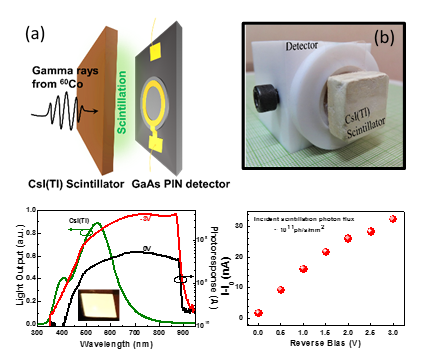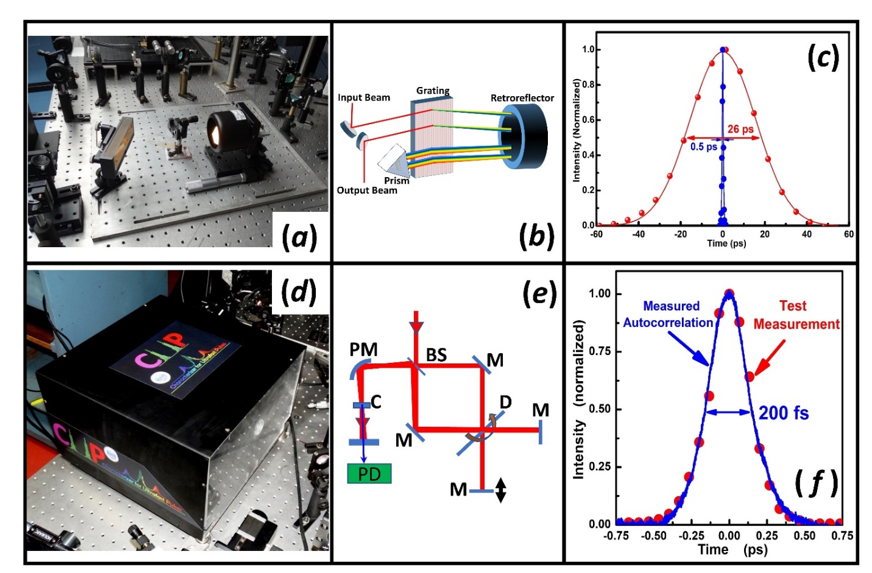|
Research Highlights
a. R&D on the Departmental Projects
1. Development of CsI(Tl) coupled GaAs γ-ray detector
The gamma-ray and x-ray detectors are widely used in synchrotron facilities, medical and space applications. The performance of such detectors mainly depends on the semiconductor material properties. Germanium is the most matured high-Z semiconductor and is widely preferred for such applications, but it has several limitations for room temperature operations. In the last few decades, III-V compound semiconductors like GaAs, CdTe, and GaN have emerged as promising materials for such applications due to their superior radiation tolerance compared to their elemental semiconductor counterparts. Improvements in epitaxial growth and device processing of GaAs-based materials led to the development of room temperature high responsivity γ-ray and x-ray detectors. At RRCAT, we have developed a prototype scintillator CsI(Tl) coupled GaAs PIN junction-based radiation detectors and used them for γ-ray detection at room temperature. In this detector configuration, initially, the gamma photon interacts with matter, by the most dominant interactions like photoelectric absorption, Compton scattering, and pair production. The high-energy photon interacts with the scintillator lattice resulting in the creation of electron-hole pairs. This is followed by the transport of the carriers to the luminescence center and consequently leading to radiative recombination (Fig A.1). Thus, the single crystal scintillator facilitates the conversion of high-energy γ-photons into visible photons. These photons generates electrical signal in the GaAs PIN junction device which is measured as a function of photon flux. In such detection application, one of the foremost requirements is the spectral overlap of the scintillator’s emission band with the spectral photo-sensitivity of the detector material.
The scintillator-detector assembly made by us was irradiated by γ-rays originating from a 60Co source with an activity of 9 Curie in the Radiation Instrument Calibration Facility at RRCAT. For an incident flux of the order of 107ph/s/mm2 and CsI(Tl) crystal with scintillation yield of 65 ph/keV, visible photons of 2.27 eV are generated. These photons are then optically coupled to the GaAs detector, producing an output current of 32.44 nA at an applied reverse bias of 3V. The bias-dependent gamma-ray response of the developed detector is shown in Fig. A.1, where I0 denotes the dark current. In conclusion, room temperature coupled scintillator-semiconductor detectors are ingeniously developed and used for the detection of γ-rays.

Figure A.1: (a) Schematic diagram of the gamma ray detection process in combined Scintillator-GaAs semiconductor detector, (b) Photograph of the scintillator-detector assembly, (c) Spectral overlap of scintillator’s emission profile with the photo-response of the GaAs detector, inset shows photograph of the scintillator emission upon interaction with high energy photons, (d) Response of the scintillator coupled GaAs detector upon exposure to 9 Curie Cobalt-60 source.
Status on 20 Sep, 2021
2. Ultrafast Pulse Characterization and Tuning of the Properties of Control and Excitation Pulses in the Coherent PL Setup
We have a setup for the measurement of de-coherence time down to 100 femtosecond time scale is our lab. The characteristics of the excitation and control beams in the existing de-coherence measurement setup were fine-tuned with an aim of controlling the coherent PL signal. For this purpose, different configurations to shape the pulse using dispersive prisms and gratings were tried in different geometries. A single grating-four pass geometry setup has been integrated in the de-coherence measurement setup for varying the pulse width of the control beam in the range of 0.1 to 26 ps, polarization and intensity in the range 0.04 to 2 mJ/cm2. Fig A.2 (a) and (b) shows the photograph and schematic diagram of the setup. Fig A.2 (c) shows representative autocorrelation traces corresponding to pulse widths of 0.5 ps and 26 ps.
A compact setup: “characterizer for ultrafast pulses” (CUP) has also been developed (photograph - Fig. A.2 (d) and schematic - Fig A.2 (e)). This setup can be easily switched between three different modes, interferometric autocorrelator mode, intensity autocorrelator mode and FROG mode, which can be used for measuring the electric field (intensity and phase). The setup can detect laser pulses in the range of 40 fs to 1 ps pulse width. The setup is capable of measuring pulse width of beam in wavelength range 700 nm to 950 nm with low average power approaching 60 mW. Fig A.2(f) shows a typical autocorrelation trace measured using this setup (200 fs) and a comparison with normal standard translation method to verify the correctness of the established method.

Fig. A.2 (a) and (b) shows the photograph and schematic diagram of a single grating-four pass pulse width control setup respectively, (c) two typical autocorrelation traces and corresponding pulse widths. (d) and (e) shows the photograph and schematic of the ultrafast pulse characterization setup respectively and (f) the autocorrelation measured by using this setup by two different delay generation methods: red dots-standard translation stage movement method and blue line-the established rotating glass plate method.
Status on 20 Sep, 2021
3. Development of customized GaAs p-i-n photodetectors as per user requirements
15 Nos of the specified single and dual elements based GaAs p-i-n photodetectors are developed by performing the device structure growth by MOVPE, multistage processing, bonding, testing and packaging. The developed detector works in the wavelength range of 325 to 850 nm with maximum responsivity of 0.58 A/W and the dark current remains < 1 nA. Temporal response of the developed detector is < 2.5 ns measured from ultrashort laser pulses. The integrated electronic circuit based on preamp, comparator and microcontroller along with in-house developed detectors are used for early arc fault detection which prevents the damage of the system by powering -off the equipment in < 1 ms. Three sets of developed detectors along with electronics are deployed in the RF circulator. In which a provision for early arc detection and the feedback mechanism for power control have been provided. No arc is detected in the circulator that was operated upto 37.5 kW power. The dual element based balanced photodetectors are also developed. The developed balanced photodetector along with amplifier is used for identifying the two laser beam originated from the same source having 1micro watt power difference. Typically 38mV amplified signal for 1micro watt power difference between the two beams is detected in the oscilloscope. Experiment is demonstrated to users and results are discussed. These balanced detectors with electronics are being packaged in a suitable metal carrier box and will be given to users.

Fig. A. 1 Photographs of indigenously developed a) single b) & c) dual element GaAs based p-i-n photodetectors, d) balanced detector along with electronics
Status on 20 March, 2020
|













